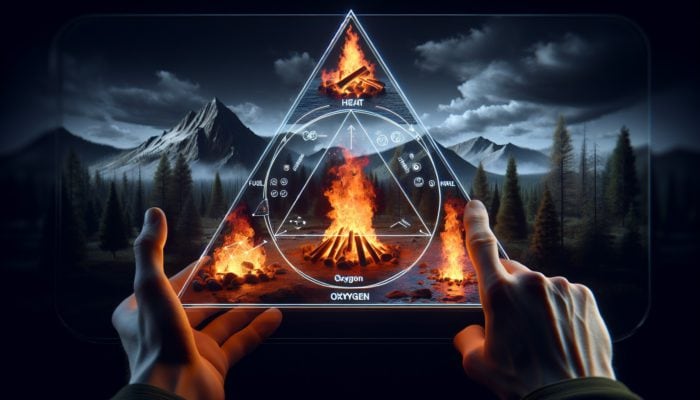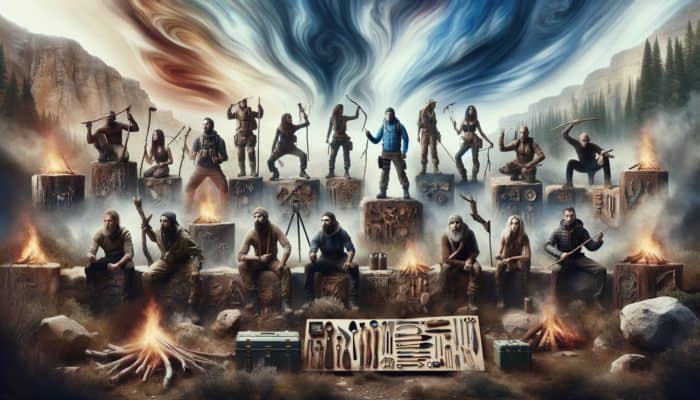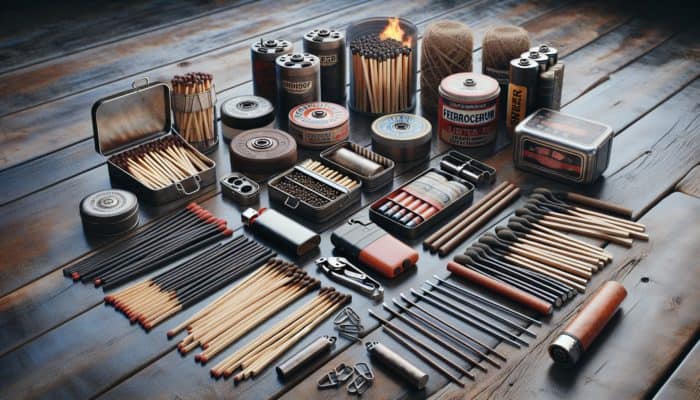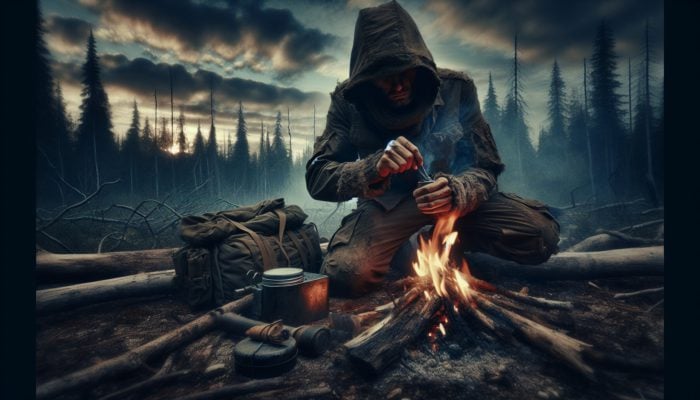Mastering the Fundamental Concepts of SHTF Fire-Starting
Comprehending the Essential Fire Triangle

Shtf Fire-Starting: The fire triangle is a fundamental concept that anyone serious about SHTF fire-starting must understand. This triangle comprises three vital elements: heat, fuel, and oxygen. Mastering these components is essential for successful fire-starting in any scenario. Without heat, you cannot ignite the fuel; without adequate fuel, the fire will lack sustainability; and without sufficient oxygen, the fire will extinguish. By comprehending how these elements interact, you can create conditions that are conducive to igniting and maintaining a fire effectively, especially in challenging environments.
The key components that constitute the fire triangle include:
- Heat: The energy source essential for initiating combustion.
- Fuel: Materials capable of burning, such as wood, leaves, or paper.
- Oxygen: Often derived from the surrounding air, it is crucial for sustaining combustion.
- Combustion: The chemical reaction that occurs when heat, fuel, and oxygen converge.
- Ignition Temperature: The minimum temperature at which a material will ignite.
- Flame: The visible manifestation of a fire where combustion takes place.
- Heat Transfer: The process through which heat moves from the flame to the surrounding fuel.
Grasping the intricacies of the fire triangle allows you to optimise your fire-starting efforts, particularly in adverse conditions where one of the elements may be deficient.
The Critical Role of Dry Tinder in Fire-Starting
Dry tinder is a crucial element in the fire-starting process, especially in survival scenarios. Its primary purpose is to ignite larger pieces of fuel, enabling you to quickly and efficiently establish a sustainable fire. Identifying and preparing the most effective tinder materials can significantly enhance your chances of successfully starting a fire in various environmental conditions. When selecting your tinder, prioritise materials that ignite with ease and burn rapidly, generating the necessary heat to ignite larger fuels.
Commonly used tinder materials include:
- Dry grass: Highly combustible and readily available in many environments.
- Bark: Particularly birch bark, which ignites rapidly due to its high oil content.
- Dry leaves: Lightweight and abundant, ideal for an immediate flare-up.
- Pine needles: These catch fire swiftly and burn intensely.
- Wood shavings: Sourced from softwoods, they offer excellent ignition potential.
- Cotton balls: When treated with petroleum jelly, they become exceptionally flammable.
- Lint from pockets: A surprisingly effective tinder that ignites easily.
Being able to identify these materials in your surroundings and knowing how to prepare them will significantly elevate your fire-starting capabilities.
What Safety Measures Should Be Taken When Starting a Fire?
When undertaking the task of starting a fire, prioritising safety is of utmost importance. Understanding the precautions to implement will help avert accidents, prevent property damage, and ensure a controlled burn. Always verify local regulations to ascertain whether you are allowed to start a fire in your selected area. Additionally, remain cognisant of wind conditions and potential fire hazards surrounding your location.
Here are some essential safety measures to keep in mind:
- Choose a safe location: Steer clear of areas near dry grass or other flammable materials.
- Clear a space: Form a fire ring by clearing a 3-foot diameter around your fire site.
- Have water available: Always keep a bucket of water or a fire extinguisher nearby.
- Monitor the fire: Never leave a fire unattended, especially during windy conditions.
- Extinguish properly: Ensure the fire is completely extinguished by pouring water and stirring the ashes.
- Know your limits: If conditions are too adverse, refrain from attempting to start a fire.
- Respect wildlife: Be mindful of animal habitats when selecting a fire site.
Implementing these safety measures will ensure a successful fire-starting experience while minimising risks associated with fire.
Insights from Experts on SHTF Fire-Starting Techniques

Fire-Starting Methods Endorsed by Survival Experts
Survival experts have refined their fire-starting techniques through years of hands-on experience, often in challenging conditions such as rain, snow, or fierce winds. Learning from their insights can significantly improve your success rate in igniting a fire under pressure. Techniques like the teepee method and the log cabin method are frequently recommended for their efficacy in creating a stable burn.
For example, in adverse weather conditions such as a rain-soaked environment, experts recommend using a combination of dry bark and small twigs as a foundational layer. Ensuring that the tinder is well-ventilated facilitates better airflow, which is essential for ignition. Additionally, employing a ferrule or a fire starter can greatly aid the process in challenging environments.
There are numerous real-world examples of successful fire-starting in adverse conditions. Consider the account of a hiker who became stranded in the wilderness during an unexpected rainstorm. By constructing a sheltered fire pit with large rocks and utilising his knowledge of dry tinder materials, he was able to ignite a fire that provided warmth and the means to cook food, ultimately leading to his safe rescue. Such narratives highlight the importance of applying expert techniques in real-life scenarios.
What Are the Most Reliable Fire-Starting Tools Available?
Having reliable fire-starting tools can greatly influence your success in survival situations, particularly when time is of the essence. Among the most trusted tools, matches, lighters, and ferrocerium rods stand out for their effectiveness and user-friendliness. Each tool has its own set of advantages, making them suitable for different scenarios.
– Matches: Compact and easy to carry, they can be effectively used in most conditions, but are vulnerable to moisture.
– Lighters: These are dependable and provide a continuous flame, although they can run out of fuel and may not perform well in extremely cold weather.
– Ferrocerium Rods: These rods are durable and can produce sparks even when wet, making them a favourite among survivalists.
– Fire Starter Kits: Often containing a variety of components for kindling, these kits are versatile and effective in multiple scenarios.
By understanding the advantages of each tool, you can make informed choices based on the environment and conditions you face.
How to Properly Maintain Your Fire-Starting Equipment?

Effective maintenance of your fire-starting equipment is crucial to ensure that it functions correctly when you need it most. Regularly checking your tools and keeping them in good condition can make a significant difference during emergencies.
For different types of fire-starting tools, consider the following actionable maintenance steps:
- Matches: Store them in a waterproof container to prevent moisture damage.
- Lighters: Periodically check fuel levels and ensure the ignition mechanism is operational.
- Ferrocerium Rods: Keep them in a dry location and clean the rod regularly to remove any residue.
- Firestarter Kits: Regularly inspect contents for usability and replace items as needed.
- Battery and Steel Wool: Store batteries in a moisture-proof case and ensure steel wool remains dry.
Implementing these maintenance practices will not only extend the lifespan of your tools but also ensure that they are ready for use when required.
Exploring Primitive Fire-Starting Techniques
Friction-Based Fire-Starting Techniques Explained
Friction-based fire-starting methods, such as the bow drill and hand drill, have been employed for centuries by indigenous peoples worldwide. Mastering these techniques enables you to start a fire without relying on modern tools, instead depending on natural resources.
To create a bow drill, follow these steps:
1. Gather your materials: You will need a spindle, a fireboard, a bow, and a socket.
2. Create a notch in the fireboard to catch the embers produced through friction.
3. Secure the spindle within the fireboard and use the bow to rotate it back and forth.
4. Apply downward pressure with the socket to generate heat until an ember forms.
5. Transfer the ember to your prepared tinder and gently blow until it ignites.
Mastering this technique requires practice, but it can be a fulfilling skill that connects you to ancestral methods of fire-starting.
How Can You Start a Fire with Flint and Steel?
Starting a fire with flint and steel is a reliable technique that has stood the test of time. This ancient method relies on generating sparks by striking steel against flint, allowing you to ignite your tinder effectively.
For a successful flint and steel fire-start, gather the following items:
– Flintstone: A hard rock that produces sparks when struck.
– Steel striker: A hardened piece of metal designed to create sparks.
– Tinder: Highly combustible materials like dry grass or birch bark.
To start the fire, strike the steel against the flint at a sharp angle, directing the sparks onto your tinder. With practice, you’ll refine your technique and be able to start a fire even in less-than-ideal conditions.
Utilising Solar Fire-Starting with a Magnifying Glass
Using a magnifying glass for solar fire-starting is an innovative approach that harnesses the sun’s energy. This method proves particularly effective in clear, sunny conditions.
For successful solar fire-starting, you need:
– A magnifying glass: To focus sunlight onto your tinder.
– Tinder: Select dry, combustible materials that will ignite with concentrated heat.
To ignite a fire using a magnifying glass, position the lens to concentrate sunlight onto a small area of your tinder. Adjust the distance until you observe a concentrated beam of light, and maintain this until the tinder begins to smoulder. The conditions necessary for success include bright sunlight and dry tinder, making this method ideal for summertime fire-starting.
Modern Fire-Starting Tools and Techniques
Understanding the Pros and Cons of Lighters and Matches
Both lighters and matches serve as convenient fire-starting tools, yet they each come with their unique pros and cons. Grasping these differences can aid you in selecting the appropriate tool for your specific circumstances.
Lighters are compact and provide a continuous flame, making them excellent for quick and easy fire-starting. However, they may prove unreliable in extreme cold or wet conditions due to fuel depletion and moisture exposure.
Matches, conversely, are straightforward and require no fuel, yet they are easily damaged by water and can be cumbersome if you are carrying a large box. Best practices for utilising these tools in survival situations include keeping them dry, being aware of how many you possess, and mastering the technique of striking matches effectively to ensure safety and success.
Why Ferrocerium Rods Are a Reliable Option for Fire-Starting
Ferrocerium rods are a preferred choice among survivalists due to their reliability in adverse weather conditions. These rods can produce sparks at temperatures exceeding 3,000 degrees Fahrenheit, making them an effective fire-starting tool even in wet situations.
For successful use of a ferrocerium rod, consider the following tips:
- Use a sharp edge: Scrape the rod with a metal blade to generate sparks.
- Utilise dry tinder: Ensure your tinder is dry and ready to ignite quickly.
- Angle matters: Hold the rod at the correct angle to maximise spark generation.
- Practice regularly: Frequent use of the rod will enhance your technique and efficiency.
Incorporating ferrocerium rods into your fire-starting toolkit increases your versatility and resourcefulness in various environments.
Employing the Battery and Steel Wool Method for Quick Fire-Starting
The battery and steel wool method is a quick and ingenious technique for starting a fire using common items. This method is especially useful in survival scenarios where traditional tools may be unavailable.
The best types of batteries for this method include:
– 9V batteries: These provide a robust electrical current that ignites the steel wool efficiently.
– AA or AAA batteries: These can also be effective, but may require more effort to generate a visible spark.
To utilise this method, take a piece of steel wool and connect it to the battery terminals. The electrical current will heat the steel wool, causing it to ignite. Once it sparks, transfer it to your tinder and gently blow to achieve a flame. This technique is not only effective but also showcases resourcefulness in survival situations.
Fire-Starting Techniques in Adverse Conditions
How to Start a Fire in Wet Weather Conditions?
Starting a fire in wet weather can be particularly challenging, but it is achievable with the right strategies. The key lies in preparation and ingenuity. Focus on gathering dry tinder and constructing a sheltered fire pit to shield your fire from rain.
Best practices for preparing fire-starting materials in wet conditions include:
- Collect dry materials: Look for dry grass, bark, or twigs sheltered under trees or rock overhangs.
- Use a fire reflector: Creating a barrier can help shield your fire from wind and precipitation.
- Layering: Start with tinder, then add small twigs, gradually increasing to larger logs.
- Patience is key: Take your time to ensure materials are adequately dry before attempting to ignite.
Understanding and implementing these techniques will significantly improve your chances of successfully starting a fire in challenging wet conditions.
Effective Strategies for Starting a Fire in Windy Conditions
Wind can create significant obstacles when attempting to start a fire, often extinguishing small flames before they have a chance to catch. Employing effective strategies to shield your fire can greatly enhance your chances of success.
The most effective windbreaks for fire-starting include:
- Natural barriers: Utilise rocks or trees to create a shield against the wind.
- Constructed barriers: Build a fire pit using logs to form a windbreak.
- Reflective surfaces: Mirrors or aluminium foil can help redirect heat toward the fire.
- Positioning: Set your fire in a sheltered area, away from direct wind exposure.
By employing these strategies, you can protect your fire from being extinguished by gusts, allowing you to achieve a successful burn even in challenging conditions.
Cold Weather Fire-Starting Techniques to Overcome Challenges
Cold weather can pose unique challenges to fire-starting, often complicating the process due to dampness and the need for warmth. However, with the right techniques, you can effectively overcome these obstacles.
Key considerations for fire-starting in freezing conditions include:
- Warm your materials: Keep your tinder and kindling close to your body to ensure they remain dry and warm.
- Build a platform: Elevate your fire materials off the snow or ice to prevent moisture absorption.
- Use dry wood: Look for dead branches that are unlikely to have soaked up moisture.
- Layering technique: Start small and work your way up to larger logs to create a stable flame.
By focusing on these elements, you can successfully start and maintain a fire that provides warmth and light, even in the coldest situations.
Research-Backed Benefits of SHTF Fire-Starting
The Psychological Comfort Offered by Fire in Survival Situations
The presence of fire in survival scenarios extends far beyond its practical applications; it provides significant psychological comfort. In emergencies, the warmth of a fire can instill a sense of safety and comfort, alleviating feelings of anxiety and isolation.
Mastering fire-starting skills can profoundly enhance mental resilience. The knowledge that you can generate warmth, prepare food, and signal for assistance can transform a dire situation into one where you maintain a sense of control and hope. Research into psychological resilience supports the idea that when individuals can uphold a sense of agency—like starting a fire—they are more likely to experience reduced levels of stress and anxiety during emergencies.
In essence, fire holds a deep psychological significance, serving not only as a survival tool but also as a beacon of hope, bolstering the human spirit during trying times.
How Does Fire Enhance Chances of Survival?
Fire serves as a cornerstone of survival, contributing significantly to human well-being in numerous ways. It provides warmth, light, and a means to cook food—all vital elements that enhance survival chances in the wilderness.
The primary ways fire contributes to survival include:
- Warmth: Crucial for preventing hypothermia in cold environments.
- Cooking: Fire allows for the preparation of food, making it safer and more palatable.
- Signal for help: Smoke from a fire can attract attention in rescue situations.
- Protection: Fire can deter wildlife and insects, creating a safe zone.
Understanding fire’s role in survival amplifies its importance in emergency preparedness, making fire-starting skills indispensable.
Environmental Considerations of Fire-Starting Practices
While fire can be an essential survival tool, it is crucial to understand the environmental impact of fire-starting practices. Responsible fire use minimises ecological footprints, ensuring that natural habitats remain intact for future generations.
To practice eco-friendly fire-starting, consider these best practices:
- Leave No Trace: Ensure your fire is fully extinguished and that no trace is left behind.
- Utilise established fire pits: Whenever possible, use existing fire rings to minimise soil disruption.
- Burn only what you need: Limit the amount of wood burned to prevent unnecessary resource depletion.
- Choose biodegradable materials: Avoid using chemicals or non-natural products when igniting a fire.
By adhering to these guidelines, you can enjoy the benefits of fire while being respectful of the environment, promoting a sustainable approach to fire-starting.
Practising and Enhancing Your Fire-Starting Skills
The Importance of Regular Practice for Mastery
Regular practice is vital for mastering fire-starting skills. The more you familiarise yourself with different techniques and tools, the more confident you will become in your ability to start a fire under a variety of conditions.
Effective methods to practice include:
- Scheduled drills: Set aside time each week to practice different fire-starting methods.
- Vary conditions: Practice in diverse weather and terrain to simulate real-world challenges.
- Invite friends: Turn practice into a group activity to share tips and techniques.
- Document progress: Keep a journal of successful methods and insights from each practice session.
Regularly honing your skills ensures you are prepared for emergencies, fostering both competence and confidence in your fire-starting abilities.
Learning from Mistakes to Improve Fire-Starting Skills
Mistakes are an inevitable part of learning to start a fire, but they provide valuable lessons that can accelerate your improvement. Analysing your failures and adjusting your strategies is key to growth in this skill.
Common mistakes to avoid when starting a fire include:
- Neglecting tinder quality: Always ensure your tinder is dry and suitable for ignition.
- Overcomplicating the process: Keep techniques simple, especially when starting a fire for the first time.
- Ignoring wind conditions: Failing to consider weather factors can hinder your fire-starting efforts.
- Insufficient materials: Always have a surplus of tinder, kindling, and fuel to work with.
By recognising and learning from these mistakes, you can refine your approach and develop a more effective fire-starting technique.
How to Effectively Teach Others Fire-Starting Skills?
Sharing your fire-starting skills with others can be immensely rewarding. Teaching beginners not only reinforces your understanding but also fosters community and preparedness.
Key steps in teaching fire-starting to novices include:
- Start with theory: Explain the fire triangle and the significance of heat, fuel, and oxygen.
- Demonstrate techniques: Show various methods, highlighting the pros and cons of each.
- Encourage hands-on practice: Provide opportunities for students to practice under supervision.
- Offer constructive feedback: Guide them through challenges and celebrate small successes.
Teaching others not only helps them acquire vital skills but also strengthens your own mastery of fire-starting techniques.
Proven Strategies for SHTF Fire-Starting
Constructing a Fire Lay for Diverse Purposes
Different fire types serve unique purposes, ranging from cooking to signalling for help. Understanding how to build the right type of fire for your needs is essential for effective fire-starting.
Actionable steps for constructing various fire lays include:
- Teepee Fire Lay: Arrange kindling in a teepee shape around tinder for quick ignition.
- Log Cabin Fire Lay: Stack logs in a square formation around a teepee for long-lasting burns.
- Star Fire Lay: Position larger logs in a star pattern around a central fire for a steady, controlled flame.
- Platform Fire Lay: Elevate the fire using rocks or logs to minimise moisture absorption in wet conditions.
Each fire type has specific benefits, and selecting the appropriate type for your needs enhances the efficiency and effectiveness of your fire-starting efforts.
How to Select the Best Fire-Starting Location?
Choosing the right location for your fire is crucial for both safety and efficiency. The environment can influence the fire’s performance and your safety, so consider the following factors:
Important considerations for selecting a fire-starting location include:
- Proximity to resources: Ensure you have easy access to wood, tinder, and water.
- Wind direction: Set up your fire with the wind at your back to ensure safety.
- Distance from flammable materials: Keep your fire away from dry grass, trees, and structures.
- Flat surface: Choose a stable, level area to prevent accidents.
By evaluating these factors carefully, you can optimise your fire-starting efforts while maintaining safety.
How to Maintain a Fire for Extended Periods?
Keeping a fire burning over an extended duration can be challenging, especially in adverse conditions. Implementing effective techniques can ensure your fire continues to burn steadily.
Best practices for managing a long-lasting fire include:
- Use large logs: Incorporate larger logs into your fire to extend burn time.
- Layering: Build your fire in layers, starting with smaller fuels and gradually adding larger logs.
- Monitor airflow: Ensure proper ventilation to keep the fire burning efficiently.
- Be prepared: Keep a stockpile of additional fuel nearby to add to the fire as required.
By employing these strategies, you can effectively manage a fire for longer durations, ensuring it meets your needs for warmth, cooking, or signalling.
How to Select the Right Fire-Starting Tools?
Choosing the best tools for fire-starting is crucial and depends on your environment and circumstances. Each tool offers unique advantages and disadvantages, influencing their effectiveness in various situations.
The most effective tools for different environments include:
- Ferrocerium Rods: Ideal for wet conditions due to their reliability and spark production.
- Lighters: Perfect for quick ignition in dry environments.
- Matches: Best suited for controlled settings where moisture is not a concern.
- Firestarter Kits: Excellent for beginners, as they provide a range of materials for successful ignition.
Understanding the pros and cons of each option enables you to ensure reliable fire-starting in your specific environment.
Using Natural Materials for Effective Fire-Starting
Identifying and employing natural materials for fire-starting is a vital skill that enhances your resourcefulness in survival scenarios. Many natural resources are abundant in the wild and can be effectively utilised.
Best natural resources for fire-starting include:
- Dry leaves: Lightweight and highly flammable, making them excellent tinder.
- Twigs: Small branches that ignite easily and provide initial flames.
- Bark: Particularly birch bark, known for its oil content that facilitates ignition.
- Pitchwood: Wood saturated with resin, igniting quickly and burning hot.
Learning to identify and prepare these materials will significantly enhance your fire-starting capabilities, allowing you to succeed in various environments.
Essential Components of a Fire-Starting Kit
What to Include in Your Fire-Starting Kit and Why
A well-prepared fire-starting kit can be a lifesaver in survival situations. Discover the essential components to include for optimal effectiveness:
- Ferrocerium rod: Reliable for generating sparks in any condition.
- Waterproof matches: Ensure you have ignition sources even in wet weather conditions.
- Fire starter squares or tinder: Ready-to-use options that catch flame quickly.
- Cotton balls with petroleum jelly: Highly flammable and easy to store.
- Ziplock bags: Useful for waterproofing lighter materials.
By incorporating these components in your kit, you ensure a versatile approach to fire-starting that can adapt to various situations.
Why Waterproofing Your Fire-Starting Kit is Essential
Waterproofing your fire-starting materials is vital for maintaining their usability in wet conditions, significantly increasing your chances of starting a fire when it’s most needed. Ensuring that each component is stored in a waterproof container or treated with moisture-resistant materials can make a critical difference in survival scenarios.
Utilising waterproof bags or containers will safeguard your matches, tinder, and other fire-starting tools from the elements, enabling you to rely on them when the stakes are high. By prioritising waterproofing in your fire-starting kit, you prepare yourself for unpredictable conditions, ensuring that you can create fire whenever necessary.
Common Questions and Answers
What constitutes the fire triangle in fire-starting?
The fire triangle consists of heat, fuel, and oxygen. All three elements must be present for a fire to ignite and sustain itself.
Can I use wet materials as tinder?
Although wet materials are more challenging to ignite, you can still utilise them if you discover dry materials underneath or sheltered from moisture.
What is the easiest fire-starting method for beginners?
Utilising waterproof matches or a lighter is typically the simplest method for beginners, as they provide a reliable flame.
How can I practice fire-starting safely?
Select a controlled environment away from flammable materials, and have water or fire extinguishers readily available during practice.
Which tools are best for fire-starting in wet conditions?
Ferrocerium rods and waterproof matches are ideal for wet conditions since they can produce sparks or ignite easily despite moisture.
How do I maintain my fire-starting tools?
Regularly check your tools for functionality and store them in dry, safe locations, ensuring they remain ready for use when needed.
What psychological benefits does fire provide in survival situations?
Fire offers warmth, comfort, and a sense of safety, helping to reduce anxiety and enhance morale during emergencies.
Is it advisable to use chemicals to start a fire?
Utilising chemicals for igniting a fire is generally discouraged as they can be hazardous and detrimental to the environment.
What are the primary ways fire enhances survival chances?
Fire provides warmth, facilitates cooking, offers light, and serves as a signalling mechanism in survival scenarios.
How can I effectively teach others fire-starting skills?
Begin with theory, demonstrate techniques, encourage hands-on practice, and provide constructive feedback to reinforce learning.
Explore our world on X!
Wilderness Fire Safety: Essential Tips and Techniques
Mastering Wilderness Fire Safety Fundamentals What Are the Primary Sources of Wilderness Fires? Wilderness Fire Safety: Wilderness fires can ignite from numerous sources, which are mainly divided into natural and human-induced factors. Among natural causes, lightning strikes are particularly notorious for igniting dry vegetation, especially in remote, arid regions. Under optimal weather conditions, these fires […]
Survival Compass Guide: Essential Tips for Navigation
Mastering Compass Navigation: Essential Knowledge and Techniques What is a Compass and Its Importance? Survival Compass Guide: A compass is an indispensable navigational tool that enables individuals to ascertain direction in relation to the Earth’s magnetic poles. This device typically features a magnetised needle that consistently points towards magnetic north, facilitating orientation in unfamiliar terrains. […]
SHTF Hunting Skills: Essential Techniques for Survival
Mastering the Essentials of SHTF Hunting Gaining Insight into Prey Behaviour for Success SHTF Hunting Skills: Understanding the habits and patterns of various animals is fundamental to increasing your chances of a successful hunt. This knowledge is not merely beneficial but essential for survival in any environment, particularly during an SHTF scenario where food sources […]
Wilderness Weather Prediction: Essential Techniques
Comprehending the Dynamics of Wilderness Weather Patterns Key Factors That Influence Weather Variability in Wilderness Areas Wilderness Weather Prediction: The weather in wilderness regions is a multifaceted interaction among numerous elements that can fluctuate dramatically depending on the surrounding environment. One of the most significant factors is altitude; as one ascends, temperatures generally decrease, which […]








Your exploration of the fire triangle underscores its critical role in SHTF scenarios, and it’s fascinating to consider how this foundational concept extends beyond merely starting a fire. In survival situations, the ability to produce fire can be a matter of warmth, cooking, signaling for help, or warding off predators—making it an essential skill.